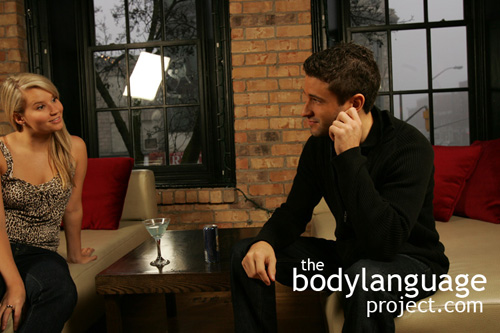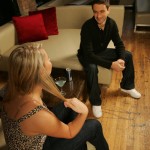As we have seen liars are difficult to detect and sometimes body language is more of a distraction than a help, however, as mentioned throughout, most people still rely on visual cues and identify (at least in their mind) liars through their body language. While these cues are only sometimes useful in detecting lies, they are always valuable as cues to avoid if the desire is to appear honest and trustworthy in the eyes of others. In other words, here is a list of cues to avoid emitting yourself!
Tag Archive for Liars
Lying In Children
by Chris Site Author • March 6, 2013 • 0 Comments
Unfortunately, you probably thought that I would be describing how easy it is to spot lies told by children, but the common theme in this chapter is held consistent. Being able to ‘look through our children’ is a common sentiment. We do think that children are bad liars overall, but studies show that children are nearly as, if not just as efficient at lying as adults. A 2007 study by Leif Strömwall, Pär Granhag and Sara Landström of Göteborg University in Sweden found that overall detection of lies in children was only around fifty-two percent, or not much better than chance. Adult raters were only slightly more effective at detecting children’s lies when the children were not allowed time to prepare their fibs. In this case they were only fifty-six percent accurate. The children relied on their own real life experiences and those of others they knew to fabricate believable stories, whereas their nonverbal strategy was to ‘stay calm’. Other research tells us that children as young as four are able to construct and build lies, but that older children are more skilled than younger children and are therefore caught even less. Another study showed that by age twelve, children have reached adult success levels. Further to this, there is no ‘expert advantage’ mean that when college students were compared to teachers and social workers, no difference was found, they all performed poorly as lie detectors.
Now let’s all breath deeply here! Children have a natural knack for telling lies, but so too does the rest of the world it seems. To catch our children’s lies it’s best to watch for their verbal inconsistencies rather than their nonverbal language. In fact, that is exactly what we do. Paying particular attention to the consistencies in the verbal dialogue is reported by several studies as successful where adults are trying to catch children in lies. To illustrate this point I draw on a 2002 study by Victoria Talwar and Kang Lee of Queen’s University in Kingston Ontario, Canada. In the study they had children hold a stuffed Barney toy behind their backs. As the experimenter left the room, they asked for them not to peek. Almost no one could resist the temptation. Raters who had no chance to interview or listen to children speak, but had to rely on body language alone, showed similar difficulty as other studies when trying to pick which of the children where lying. However, when outright asked if they peeked seventy-five percent lied and only twenty-five percent admitted to peeking, but when asked to guess what toy they held, almost half of the six and seven-year-olds said “Barney” admitting they had looked, whereas ninety percent of the three, four and five-year olds admitted the same. The study demonstrates that young liars are easily read by verbal leakage. Only some of the students where able to come up with alternative answers, or report that they didn’t know.
Another factor we look for in liars, is “richness of detail”’, meaning the level of information in a story. It is this richness that we assume means that someone has actually experienced the event, rather than constructed it. Children have limited life experience and it is difficult for them to create details outside of their personal lives. Then again, young children often give short responses to questions anyway and offer up little detail, even when prompted. Children have also been found to appear more nervous and seem to think harder when lying, the problem of course is that they hold these traits while telling the truth as well. Telling the truth is hard for both adults and children. Reality is as difficult to recall as is creating lies.
Adults, parents in particular who spend a great deal of time with their children, can usually pick out lies easier, because they’ve been with them to measure their experiences more so than the cues they give up through their body language. However this falls much shorter than lie detection, it’s merely an examination of the facts or at its most generous, a probability assessment. Parents most often rely on baseline comparisons in their children and while this is helpful, detecting lies in strangers or in other people’s children would be more useful. Teachers whom are faced with stories about summer vacations or their extravagance might hold doubts, but until they can confirm these doubts with facts, photographs or even parent’s confirmation, they simply remain doubts. Information presented outside the realm of the children’s possible experiences can be used to reasonably detect lies, but with widespread media and internet, story creation by children is made much easier. However, as the research shows repeatedly, we should not expect to be able to detect lies through body language alone, even in children.
Touch Reduction
by Chris Site Author • March 6, 2013 • 0 Comments
Touch reduction is usually accompanied with stressful questions or when information is presented that creates anxiety. Closeness can also be useful when assessing someone because it will invoke distancing desires. When talking with a spouse or child, sit as close as that which you are accustomed to before taking up serious matters. If someone is hiding something, they will usually push away or even stand up looking for ways to exit or change the subject. Holding the hand of a child can be particularly useful when discussing matters of dishonesty. If they wish to exit the discussion, they will try to tug their hand away.
Remaining Uncommitted
by Chris Site Author • March 6, 2013 • 0 Comments
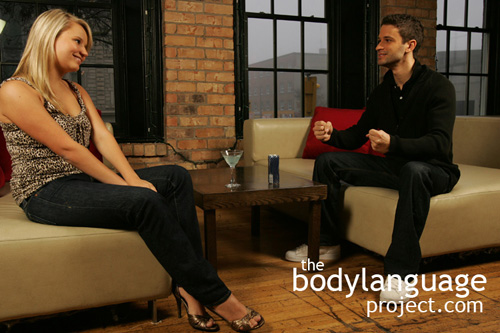
When people tell the truth they will usually show extra enthusiasm and commit to their story. Liars often start off the same way, but quickly trail off.
Liars will motion without emphasis, or describe events by trailing off or use weak statements. They might limit arm and hand movement by clasping them together or locking them down on an armrest with such force they turn their knuckles white. The hands might be put out of sight in pockets or under a table where they can’t be read. Reduced movement can be seen throughout the body, not just in the hands. The entire body including the head, arms, feet, and torso can seem to lock in place. People that are telling the truth spend a lot of time and energy in efforts to make the facts known which comes across in their body language and gesturing. Truth tellers are happy to spend as much time as necessary to get everything right. They will often add more detail than required and go over it again and again if necessary. Not emphasizing is linked to the freeze response where the mind clams the body shut and reduces movement so as to draw less attention to it. What is important in lie detection is to compare cues from a baseline. That is, if someone suddenly drops emphasis then you know they’ve lost interest in the topic or are lying. In either case, it will have provided useful information to the body language reader.
In writing this passage, I had just reviewed a video (see bottom posted on the web of a baseball game in which a player leaped head-over-feet clear over the catcher as he came to homeplate to score a run. The catcher, stuck in a fear response, failed to tag the runner. Baseball has an interesting tradition where it is customary for the runner to body-check the catcher at homeplate as he tries to tag for an out. While the catcher braced and ducked with his elbow up to make the tag, the runner jumped over the catcher landing on home plate. The catcher stuck with his elbow up in defense could only convince his mind to bring his arm just close enough to miss the tag! Because his mind feared the body check, he wasn’t able to follow through with what he intended. While this is an interesting fear based response what follows is even more interesting since it helps us read liars. The catcher, realizing he failed to get the out, quickly turns to pursue the runner. One must ask why he would track the runner down if he made the tag? Obviously he hadn’t! But more important that this, is that we know that he knows that he didn’t make the tag! This means that any nonverbal language following the lack of tag, should he dispute it, is read as lying language. To state his case, the catcher chats with the umpire by raising his arms showing how he made the tag. What is revealing, however, is that the catcher only slightly raises his arms instead of doing it with emphasis. Instead of showing the gesture over and over again, the catcher just raises his arms once as if to make a casual rainbow motion with his arms. When his coach shows up with arms flaying and talking with enthusiasm, the catcher quietly exits! The catcher knows that he can’t make a case and so doesn’t put any effort into trying. The difference between the coach and the catcher, is that the catcher knows he’s lying, while the coach isn’t sure. Once more, the coach isn’t actually lying anyway, since he wasn’t there to feel the contact or lack thereof of the catchers mitt and the runner, he’s just acting out an inherent bias – he’s playing the role he was hired to do. Lack of commitment is an important cue to watch for when detecting lies so be careful to watch for it.
Nervousness And Guilt In Lying
by Chris Site Author • March 6, 2013 • 0 Comments

“Talking out of the side of the mouth” came about because we feel that liars don’t speak to us straight; in plain terms.
One of the most reported cues of deception includes fear and nervousness. These include higher pitch, faster and louder speech, speech errors or stuttering and indirect speech or talking out of ‘the side of the mouth’ or in worse cases, the liar might even sound unpleasant. We might also see blushing of the face, neck or ears, an increase in blink rate, fidgeting, dilation of the pupils or sweating. In theory, the greater the apprehension of getting caught or the greater the stakes, the more evident these fear cues should be. As an increase in the possibility of punishment or with an increase in the severity of punishment we should also find an increase in nervous body language. The studies tell us that people who lie about something they’ve done wrong, termed a ‘transgression’, the more likely they were to show more deceptive cues presumably because they felt guilt more strongly.
We should also be cognoscente about the motivation of the liar. If they aren’t particularly vested in the lie, they might not show nervousness at all. Someone presenting a ‘white lie’ about who they were with the night previous, or their preference for chocolate versus vanilla ice cream, should be expected to show minimal nervousness. More experienced liars show very little nervousness, because, not only are they practiced at lying, they rarely get caught, so have little to worry about effectively destroying the hypothesis that nervousness specifically increases because of lying. Conversely, poor, but frequent liars, get caught so often that the consequences of their lies fail to bother them, so they also lack nervousness. We should also predict that lies told to close friends or family whom the liar cares for, should make them more susceptible to nervous body language. Here we might in fact see lower pitch, softer and slower speech and a downward gaze as they battle their consciousness. The stick in the spokes of this theory though is that sometimes telling the truth can causes guilt just the same as telling a lie, especially when it is known that the truth might hurt someone. Other times, telling the truth causes even more distress because of the shame of revealing possible shortcomings or mistakes to others. Thus, it’s a pretty safe statement to say that liars don’t always feel guilty about their lies and truth tellers don’t always feel good about their honesty. In fact, many liars justify their lies to prevent distress in other people!
Being unable or unwilling to embrace their lies is what makes lie tellers appear less truthful and convincing. So by this theory we should expect a liar to face more negative emotions when lying which truth tellers don’t face which in turn leads to at least faint feelings of discomfort which then leaks out through the body. However, again we find data to the contrary. It has been noted by researchers that liar can have less vested in their claims primarily because they haven’t actually occurred. This is counter what was presented thus far because instead of appearing more emotional, they may in fact appear less emotional. Lest we forget too that liars can present fearful emotions when they lie due to the chances of getting caught! If you haven’t gotten the point by now, you are starting to. The point is that emotions are intertwined with the fear of getting caught, anguish of lying and telling the truth and a myriad of other factors directly and indirectly related to lying.
As we know, when truth tellers speak, they are backed with an accumulation of knowledge, experience and wisdom from an event, whereas a liar is only acting out of his own imagination. This can provide clues to his deception. Therefore, the liar might offer fewer details, present their story with less emotional investment, provide less evidence to stake their claims, act less compellingly, appear less forthcoming, less pleasant and more tense. It is also important to note the motivation or context of the lie as well, as this will provide us with clues to watch for, be it nervousness, fear of getting caught and the guilt or the shame of either lying or not lying as the case may be.
Deception Causes Arousal, Generally
by Chris Site Author • March 6, 2013 • 0 Comments
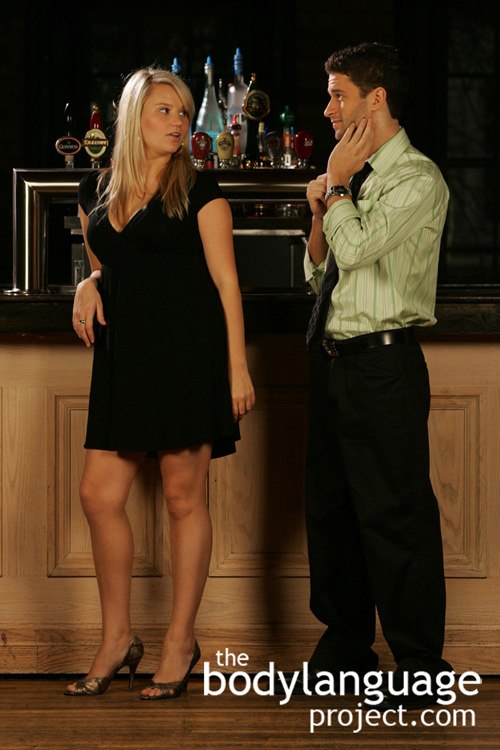
While he COULD be lying, it’s much more likely that he’s actually anxious. We instinctively (and wrongfully) link anxiety with lying, when in fact good liars often feel no anxiety whatsoever when they lie, and honest people feel anxiety when they think they will be disbelieved.
It is a widely held belief that emotional arousal and stress, is strongly tied with lying. It is also at the heart of the polygraph or lie detector. Here, autonomic responses which happen in our bodies without our conscious control such as sweating or ‘skin conductivity’ is measured as well as increases in heart rate and breathing. It is assumed that when lies occur, stress related behaviours increase. Lie detector machines measure a baseline, that is, they take readings when lying is known to occur and compare it to readings when lying is thought to occur. By reading the differences, lying should become obvious.
We can use similar methods to read arousal without the help of the polygraph. Watching for an increase in adaptors, shifting, subtle movements, touching or scratching the face, neck or nose can show us that someone is uncomfortable. What it won’t show us is the reason for the discomfort. By grilling someone for the truth, this is often enough to cause someone to feel stress thereby creating the behaviour instead of uncovering it. Other clues to an increase in stress includes an increase in eye blinking, changes in posture, avoiding eye contact and foot and leg movement. It is important to always put fear of lying and arousal into context. Someone with little fear, little to gain or loose, or in other words, ‘when the stakes are low’ wont show any of these signals. Aside from this lack of tell, it is important to realize that body language cues, especially lying language is not a result directly of lying, but rather an indication of the stress, fear and anxiety that may or may not be present when lying.
Introduction – Chapter 16
by Chris Site Author • March 6, 2013 • 0 Comments
He does not answer questions, or gives evasive answers; he speaks nonsense, rubs the
great toe along the ground; and shivers; his face is discolored; he rubs the roots of his
hair with his fingers.
—Description of a liar, 900 B.C.
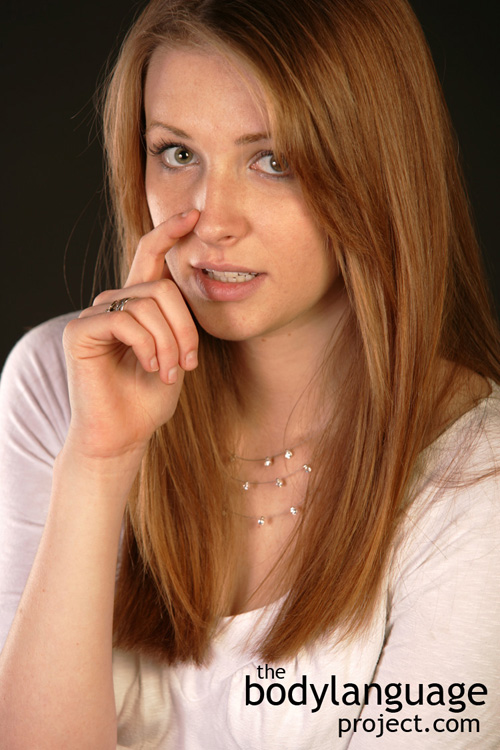
Touching the nose has long been use as a ‘tell’ when detecting lies. However, is lying just that easy to spot?
I’ve been putting off writing this chapter for some time and not for reasons of laziness. In fact, I have research the topic to death. The problem with lying related body language is that it’s not where it needs to be in order to be useful to the vast majority of people. What research on lie detection, and there is plenty, tells us, is that there is no definitive traits that give up all liars. Most of the cues are either anecdotal or happen some of the time, but not all of the time. Other studies tell us that so called experts, that is, police officers, interrogators, customs inspectors, federal law enforcement, federal polygraphers, robbery investigators, judges, parole officers and psychiatrists fair only at slightly above the fifty percent success rate. In fact, the average is somewhere around thirty-seven to seventy percent. It doesn’t take a mathematician to realize that someone flipping a coin is just as skilled at coming up with the correct answers as any one of the ‘experts’. Other research tells us that higher order interrogators aren’t able to pass on their intuitive abilities to others, telling us that they can’t quantify their observations. If they can’t pass it on to laypersons, than it’s of no practical purpose for me to pass it on either. Other times programs specifically designed and sold to improve detection of deception have failed miserably and have even lead to the detriment, rather than improvement of performance.
Several cues have been attributed to detecting lies. They generally fit into two broad classes. The first is nonverbal visual cues such as facial expressions, eye blinking, eye contact or gaze aversion, head movements, pupil dilation, nodding, smiling, hand movements or gestures, foot and leg movements and postural shifts. The second includes paraverbal cues including pitch, pauses, or speech errors. We will get into these cues in the following pages.
There are other ways that scientists use to detect lies and these involve machines. The most common is the polygraph or lie detector machine. The polygraph relies on changes in heart rate, blood pressure and increases in perspiration or respiration. However, these cues are of practically no use to us because they are difficult, although not impossible to see. For example, an increase in heart rate can be seen if one looks closely at the carotid artery that runs along the neck, and an increase in sweating does become apparent with an increase in scratching of the palms. Further to this, the polygraph has a poor track record and most experts agree that they have severe limitations and their accuracy is known to be inconsistent. As well will see, one facet of lie detection involves the reading of nervousness, but practiced pathological liars are skilled at eliminating nervousness, some even thrive on it thereby reducing the propensity of visible and invisible cues.
Notwithstanding the myriad of hard fast research on lie detection, it is still a widespread belief in the population that nonverbal behaviours betray a liar. Worldwide, cross-cultural comparison has shown a universally held belief that liars are spotted through their bodies. Police training packages will often include nonverbal and paraverbal behaviours as part of the ways in which deception can be detected. A study by Lucy Akehurst of the University of Portsmouth found that when asked which behaviours they thought would be consistent with lying, both police officers and regular lay people agreed. There was no difference between what the experts thought betrayed a liar and what regular people thought. They also agreed that these behavioural changes would occur more frequently in others as they lied, than in themselves. This finding is replicated in other studies as well. For example, police officers and students agreed on which behaviours were consistent with lying and they also thought that they themselves would display these cues less during lying. The research therefore is inconsistent with the nature of lying. It can not happen both ways, and it seems that our attitudes about lying and lie detection are skewed.
Judgments of deception are heavily correlated with long held stereotypes. Person’s that display behaviours associated with lying are often judged as deceptive even though they may be telling the truth. Study after study shows that roughly only fifty percent of the time liars give themselves away, the remaining time, liars are passed off as truth tellers and truth tellers as liars. Pegging liars based on body language alone or some other mystical cue is a dangerous assumption. It can lead to marital break-ups such as if a spouse falsely labels her husband as a cheater, can put innocent people in jail, can lead to the firing of employees on suspicion of theft and so forth. Yet with this huge propensity for error and consequence, we still, by in large, believe that we can read people on this trait. What shouldn’t surprise us are the rewards achievable through lying and cheating. Lying can avoid punishment, save us from hardships, but perhaps more importantly can help protect those around us and their feelings. The question “Does this dress make me look fat?” does not necessitate an honest answer, and in so doing, everyone is much happier!
Teachers, principles, lay persons and even intellectuals have been shown to all think similarly in terms of lie detection, and the body language associated (even if incorrect). Thus to avoid being detected, or mislabeled a liar (which is worse), we should still avoid displaying stereotypical lying body language that will serve to give us away. At this point, you should understand my reasoning for presenting this chapter even if only to slightly help us catch liars. While lying body language may be of some help in catching a liar, it will help avoid making us appear as though we are lying in the eyes of those around us. As the studies on beliefs about deception have indicated, there seems to be worldwide agreement on what constitute cues to deception in others. Therefore, it is these behaviours one should avoid so as not to appear dishonest. I will add too, that lie detection is not impossible, certain individuals do fair better than chance alone when detecting lies. However it is with caution that I present this chapter because as of yet, it is difficult to pin down exactly which cues are used and which cues happen across all people. Some cues mean deception some of the time, while other times they are simply related to emotional arousal and stress which can be due to being portrayed inaccurately as a liar, or in response to the punishment that might be forthcoming. Sometimes it is the worry about being “under the gun” that causes the stress and therefore the behaviour, and not because of any concern about the telling of a lie. While this chapter provides cues to emotionality related to lying, it will be up to the reader of the language to determine the source, be it actual lying or emotions related to being caught.
How Can We Tell If An Emotion Is Faked?
by Chris Site Author • March 6, 2013 • 1 Comment
Being able to tell the difference between real emotions and the body language that follows is a very useful skill in reading people. Being able to detect fake emotions can help us decide who we can trust and who is actually in agreement with us, versus those who are simply faking it. Liars and their body language are covered more extensively later in the book, so it is of no direct concern here. Rather, here we present rules of thumb that help us decide if facial expressions and emotions such as fear, sadness, happiness, shame, guilt and disgust are real and genuine or feigned. Emotional fakery of sadness is used to generate sympathy in order to gain various resources, and fake sadness is used to generate leniency and therefore receive help in the form of favours. Being able to detect real from fake is a useful skill because it gives the body language reader the power to decide what course of action is merited.
So how can we tell if a facial expression is fake versus real? While body language readers can never really know for certain, the face does subconsciously give us some clues that it’s not being honest. For example, a fake emotion is one where there are symmetrical differences between the right and left side of the face. That is, when the left and right side don’t match. A smiling face, where the smile is uneven is a perfect example of a false smile and one that was covered in great detail earlier. The second telltale sign of a fake expression is when it appears and disappears in a jerky, non-fluid manner. This tells us there is doubt and uncertainty. The third cue that an emotion is faked has to do with eye movements and directions. Looking downward and away indicates shame, guilt or disgust, looking down indicates sadness. The final way to detect false emotions is by catching those that seem to be held for too long, or seem over-exaggerated. Expressions that are so big that they are “over-the-top” or seem “out of this world” and don’t flow with context or match timing expectations, meaning they don’t go with what is being said, are more than likely fake.
Other times, emotions are difficult to decipher. For example, when the eyebrows go up, they sometimes indicate fear, but other times they are raised to indicate surprise. Fear is usually shown by showing the whites of the eyes, raising the upper eyelids, raising the inner brow and tightening the eyelid. However it is important to note that raising the inner brow can show sadness, lowering the brow can show anger or mental effort and tightening the eyelid can show anger or disgust.
Some expressions are only seen very rarely, which is the case with the more extreme expressions making them difficult to study. These facial expressions also happen very quickly, so it’s not always easy to spot them. Usually the expressions are encoded by the viewer in large part to the context in which we find them. For example, jumping out of the bushes and yelling at someone is bound to create a surprised look, but can you decide if a face absent of context shows fear or surprise, what about sadness? It’s not always that easy, but absent of slow motion photography and mind reading, the rules of thumb covered here can make the process simpler and more manageable.
The Ear Grabber
by Chris Site Author • March 6, 2013 • 0 Comments

When ear grabbing is done while listening to others speak it is due to disbelief, as in “I can’t believe what I’m hearing.”
The ear grab refers to a subconscious desire to “hear no evil” and is done by reaching up and pulling the ear in response to, either hearing something disagreeable, or saying something disagreeable. Children make no bones about blocking their ears when being teased or scolded by parents, but as we grow older, we drop the cue short because it is seen as juvenile, so instead we pull our ear, or earlobe. The gesture is an attempt at preventing the sounds from reaching a deeper part of the brain. It also sometimes represents anxiety and nervousness, and is classified as a defensive posture. We may see this gesture arise just as a performer is about to take the stage in front of thousands of people.
The ear grab can be use not only at the conclusion of the lies of others, but also at the conclusion of our own lies as well, and this is why it is referred to as a gesture that shows a desire to “hear no evil.” The gesture used at the conclusion of our own lies serves to reduce what is called “cognitive dissonance” which is the uncomfortable feeling that comes from holding two contradictory ideas simultaneously. For example, a used car salesman might talk about the quality of a certain car, than pull on his ear lobe, or more subtly, he might be found rubbing the edge of the ear, indicating that what he has just said is untrue. In this case, cognitive dissonance stems from the telling of a lie which is inherently bad, while a person feels that they are inherently good (it might seem odd, but everyone feels they are inherently good, even murders justify their actions). So lie tellers bridge their bad thoughts due to cognitive dissonance with the ear grab, until they have time to justify the lie to themselves. Therefore, it is the pain of the dissonance that causes the ear grab in liars.
When ear grabbing is done while listening to others speak it is due to disbelief as in “I can’t believe what I’m hearing” and the same “hearing no evil” is at play. In this case though, it is the receiver, not the sender, who wishes not to hear the lie. By touching or scratching the ears we hope that we can satisfy the nerve endings and end the discomfort. In other words, when we hear bad things, we go to our ears to try to turn the volume down. Other times, touching the ear means nothing at all and is simply the result of nervousness or boredom.
The ears often flush red when people are nervous which can be the case when they are worried about getting caught in a lie. This is why the ear grab and flushing, can be great poker tells when people are stressed about bluffing. The ear grab is a way that our bodies respond to the extra stimulation they get when agitated and we go to them to scratch or pull on them as stress relievers. Think of the ear grab like rubbing sore muscles or massaging a stiff back, except in this case the damage done is internal and it’s due to something that has been heard, which “hurts” the ears. Anytime someone shows the desire to touch their ear means that they are thinking about hearing, and it will be up to you to tie them to context and decide what it is they are really saying.
Suckling And Mouthing Body Language
by Chris Site Author • March 6, 2013 • 0 Comments
The mouth and lips are full of nerve endings which, when stimulated, provides tactile gratification and comfort. However, anytime the fingers go to the mouth or play with the side of the mouth or lip, it’s a retrogressive action since the gesture is an attempt to regain the security they had as an infant suckling and mouthing. Nail biting is also a form of emotional body language, and when present, is usually habitual because of its origins. The habit which is highly unsightly screams “I am insecure” so should be eliminated from a person’s repertoire. These types of gestures are called “pacifying behaviours” because they are designed to reduce anxiety when exposed to something distressing. Pacifying language tells us the mind is not at ease and is an attempt to restore the body’ natural state. The ears, neck and nose are also areas people will hit when their minds require pacifying and they are covered next. Pacifying can also sometimes give up liars because they can be tied or linked to specific words uttered that then in turn require the body to be stroked to create comfort. Pacifying has everything to do with releasing bad tension as a substitute to the hand of a comforting mother.
While baby mouthing has no definitive explanation, it likely stems from the need to strengthen the muscles of the jaw and tongue and increase their coordination to better handle solid foods. Ancestral babies would not have had access to processed foods and the best they would have done was mouth to mouth transfers of masticated food, or food that was broken up by hand. These foods would have contained larger bits as well that might have caused less coordinated babies to choke. When babies first start eating solid foods, they need to balance the size and dryness of the foods with how much they need to mouth it, and yet it, so as to avoid moving it to the back of the throat too soon leading to gagging and vomiting. Poor mouth coordination tied with a mother who’s milk has gone dry too soon, and you have a baby facing early death. Mouthing, therefore, has a strong selective pressure, so today we find babies that mouth whatever they can, to get all the practice they can get. A secondary explanation to mouthing behaviour is that is serves as a way to test and explore objects with a sense that it more developed.
Hand to mouth actions are the most common target for auto touching. It might stem from the concern of giving up too much information, or letting a lie slip, or due to the need for reassurance. Covering the mouth is a natural reaction children do when they tell a secret or inadvertently say a word they know they shouldn’t. Speaking through the hand also shows insecurity and is found when uncomfortable people speak in public. They will hold an elbow on the table and wrap the forefinger around outside of the mouth as they speak.
Adults that are tense or anxious will play with their mouth or lip. Mouthing a pen, cigarette, piece of their own hair, and even gum when used as a comfort device, are a substitute for the mother’s breast and early childhood mouthing. Sucking, plucking, picking or chewing the lips, rubbing them with a finger or thumb are all forms of auto touching. Confident individuals would never consider using this type of security blanket, let alone be seen touching their faces out of insecurity.







